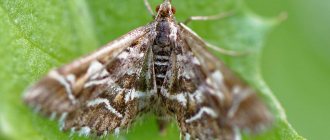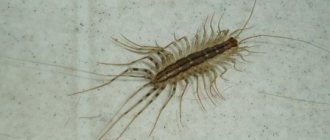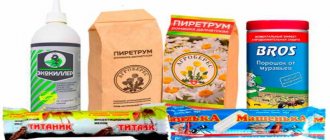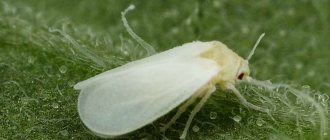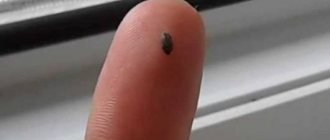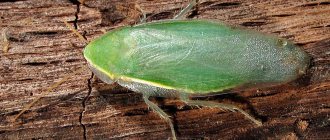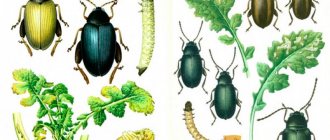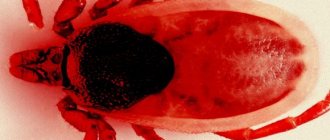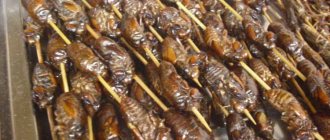The scale insect is a small, up to 5 mm, armored insect that feeds on the juices of currant leaves, ovaries and branches. The insect spreads very quickly and affects not only currant bushes, but also gooseberries, raspberries, cherries, and cherries.
The first signs are small yellow spots, which grow over time until the leaves fall from the bush. If you notice it in the early stages (yellow spot), then the bush can still be saved, but if there is a large fall of curled leaves, you need to resort to radical measures - completely uprooting and burning the branches. The need for this approach lies in the fact that the scale insect produces honeydew, which provides food for sooty fungus, another serious disease of garden plants.
In general, scale insects rarely appear on young shrubs, only if agronomic requirements for planting and care are not met. Most often it can be seen on old and unkempt currant bushes.
The most favorite place is the transition of the leaf stalk to the branch from the inside of the leaf. These places need to be constantly looked at, because not only the scale insect likes to huddle “in the shade,” but also aphids and leaf rollers.
In this article we will look at the main methods of treating scale insects.
Characteristics of an insect
The main characteristic of this parasite is that if the fight is not started in time, the insect closes itself with a shield and no drugs can destroy it until the next hatching of the larvae. The main fight comes down to the destruction of young growth, and the affected branches with scale insects will need to be cut out and burned outside the area. Find out how to fight caterpillars on currants here.
Description of appearance
Here is a brief description of scale insects depending on gender and stage of development:
Female
She has no wings or legs - so she can only move by crawling. Another difference from males is that they have a round protective shield. Maximum size up to 2 mm. The body with a chitinous shell camouflages itself with the appearance and color of the plant on which the colony of pests has settled. Depending on the plants, females can change not only the color, but even the outline and length of the body. The female California scale insect can be easily identified by a yellow spot with a white border in the middle of the shield.
Male
The elongated structure of the body is oval in shape, its color can vary from a grayish tint to yellow-black.
On its shell there is a transverse stripe, painted in a darker color. The maximum size of the shield in an adult parasite is up to 1 mm. The insect moves on its legs and can fly short distances, unlike females. Another distinctive feature for a person with a magnifying glass is that the eyes of males are purple. Several forms of Californian scale insect larvae are classified:
- “nymphs” are a transitional form; during this period, the formation of scutes begins, and their body begins to acquire an oval shape. The color changes and becomes dark black;
- “vagrants” are recently hatched individuals with an oblong body shape, colored gray. The body size is up to 0.3 mm, so the gardener will definitely need a magnifying glass to identify and detect hatched larvae. The main task at this stage for parasites is constant feeding, so their mouth is well developed and may even be longer than the body of the larva.
Life cycle
The scale insect overwinters in the form of eggs, which the female covers with her body. In the first warm days of spring, the hatched “Vagabonds” begin to actively feed and develop. Adult, overwintered individuals remain at the wintering site, they firmly adhere to the shoots or trunks and suck the sap of the plant. Males begin to care for their offspring by mid-May. Their number is small, only 10% of the total mass of the flock. Find out about the best varieties of tomatoes for open ground at this link.
Females, during the warm period, are able to lay up to 100 eggs, from which voracious larvae emerge.
These small fry quickly spread across a tree or bush or move onto neighboring plants and suck out plant juices. Beginning to transform into nymphs, the larvae become covered with chitinous scutes and become inaccessible to any drug.
Males, preoccupied with procreation, drop their protection during mating and die after fulfilling their paternal duty. Already in August, up to 90% of the females grow from the larvae, lay eggs underneath them and become covered with protection.
Where do scale insects spend the winter?
Many harmful insects, including scale insects, overwinter in the bark of trees. The larvae hide both outside and under the bark, in cracks.
The female lays red oval eggs, which overwinter under the shield of the withered female. Up to a hundred future parasites live under each shell. At the beginning of summer, red strays crawl through the currants and attach to the shoots, trunk, and leaves. After 2 moults, they become adult females who are able to lay new eggs.
The cushion plant overwinters on branches, at the base of bushes, under the skin. The eggs of the comma scale insect are hidden in cracks in the bark, under the shell of females that have dried out in the fall.
A pest of plums, gooseberries, currants, white acacia, maple, the acacia false scale insect hides red-orange larvae for the winter on branches, on the inside, in places of branches, near the buds. The egg laying looks like flour or white powder.
See also
Description and characteristics of Pygmy currant variety, planting and careRead
Mature scale insects do not leave the winter place, settle on the trunk or branches of the plant, and feed on its juices. Even before the start of summer, anxious males think about their offspring. When mating, they throw off their protective shell and die. During the period of transformation into nymphs, a chitinous shield is formed on the body of the larvae. After its appearance, the parasite is not afraid of any drug.
Symptoms of the lesion
If the larvae can only be seen under a magnifying glass, then the consequences of their “feeding” and development are easy to detect.
The foliage on the plants becomes sticky and shiny, as if they had been smeared with honey. Already at this stage it is too late to start fighting; usually the scale insects are covered with protection. The coating tastes sweet, this is due to the release of sweet and sticky waste by the feeding “vagrants”. Then the shoots and trunks become covered with a grayish coating; due to a lack of nutritious sap, the plant begins to lag behind in development, the foliage becomes small and gradually dries out. The plant’s nutrition from photosynthesis processes is disrupted and, in fact, the plant stops “breathing” through the foliage. Early leaf fall begins, the bark on the trunks and shoots cracks and bends. Find out how to spray currants in the spring against pests and diseases in this material.
Consequences
A gardener who does not carry out preventive treatments against scale insects on currants and other garden plants risks being left without a harvest and will lose seedlings altogether. If at the beginning, due to insufficient nutrition, parts of the bush are depressed, then later the lack of nutrition causes the shoots and trunks of the bush to dry out. This article will tell you about ammonia for aphids on currants.
It is not always possible to reliably protect the garden, even if all preventive treatments are carried out, if the neighboring area is abandoned or not treated for pests. In this case, active males and “vagrants” will quickly fill the neighboring garden and young females will hatch in August.
Willow scale insect on currants - how to fight and get rid of it
The scale insect is a small, up to 5 mm, armored insect that feeds on the juices of currant leaves, ovaries and branches. The insect spreads very quickly and affects not only currant bushes, but also gooseberries, raspberries, cherries, and cherries.
The first signs are small yellow spots, which grow over time until the leaves fall from the bush. If you notice it in the early stages (yellow spot), then the bush can still be saved, but if there is a large fall of curled leaves, you need to resort to radical measures - completely uprooting and burning the branches. The need for this approach lies in the fact that the scale insect produces honeydew, which provides food for sooty fungus, another serious disease of garden plants.
In general, scale insects rarely appear on young shrubs, only if agronomic requirements for planting and care are not met. Most often it can be seen on old and unkempt currant bushes.
The most favorite place is the transition of the leaf stalk to the branch from the inside of the leaf. These places need to be constantly looked at, because not only the scale insect likes to huddle “in the shade,” but also aphids and leaf rollers.
In this article we will look at the main methods of treating scale insects.
Pest control
To protect plants you will need to use all available methods. We will examine them in more detail in separate chapters.
Agrotechnical methods
Among agrotechnical activities, we highlight several main types of work in the garden:
- One of the effective ways that can prevent the spread of scale insects throughout the garden and neighboring plants is autumn hilling of bushes. This will additionally protect the bushes from frost. In early spring, during the period of snow melting, the earth is raked away from the bush and the females, who have climbed under the warm earthen cushion, die.
- If several bushes have been attacked by scale insects, and all the remaining plants have escaped this fate, we recommend covering the affected bush with a covering material and opening it only when treating with chemicals - this is the most effective way to prevent the spread of larvae and males throughout the area.
- It is impossible to destroy adult females, males and nymphs using any drug; they are used to destroy the larvae of “vagrants” and males during the period of fertilization of females. Therefore, when we see a shoot with a large number of pests scattered across it under its shields, we simply remove it. Be sure to immediately burn it in a barrel or on a fire outside the site.
- You can try to save the plant, especially if it is a trunk or skeletal branch of a tree. To do this, use a toothbrush, cotton pad or sponge to wipe all the shoots and remove attached pests. To facilitate mechanical cleaning of scale insects, preparing a soap solution and applying it to the shoots before using a sponge or cotton pad will help. It is recommended to additionally wash the foliage with a thick aqueous solution of laundry or tar soap.
It is better to wash and wipe the shoots and foliage on the bush completely. It is not a fact that a scale insect has not settled on them, even if you were unable to detect it.
Chemicals
To treat the garden against scale insect larvae, we recommend using contact preparations. According to reviews from gardeners, the use of neonicotinoids shows good results, among which we highlight several compounds:
- "Aktara";
- "Colorado";
- "Apache";
- "Mospilana";
- "Tanreka."
To prepare the solution, after reading the instructions on the package, dilute and stir the drug thoroughly. Pour it into the sprayer and evenly cover all parts and foliage of the bushes on all sides.
After spraying, we must not forget about cultivating the soil around the tree trunk.
In addition to these drugs, many gardeners use solutions of organophosphorus and hormonal agents:
- "Kemifos";
- "Sparks";
- "Admiral";
- "Pyriproxyfen."
Repeated treatment of plants with chemicals during the period of growth of “vagrants”, whose bodies are not protected by chitinous armor, will help increase the chances of destroying scale insect larvae and eradicating the existence of these pests on currants.
Traditional treatment
Folk remedies are various decoctions or infusions. For mechanical removal of larvae and adults, use a solution of 30-40 g of laundry soap and 10 liters. water. Here are a few recipes for folk remedies against scale insects on garden plants and currants:
- To prepare a medium-sized garlic infusion, take 5 cloves of garlic, remove the shells and grind them to a pulp. You can use a fine grater or garlic press. Add the same volume of laundry soap, add 3 parts water and leave for 48 hours in a dark place. We wipe the affected areas and all parts of the plant with the prepared infusion.
- The tobacco infusion is prepared according to the following scheme: pour 1000 g of leaves or tobacco dust into 10 liters of rainwater, let it brew for a day and spray all parts of the plant.
- It is recommended to prepare a decoction of hot peppers - add 50 g of fresh peppers to 500 mg of water and simmer over low heat for 5-7 minutes. Place the container in a dark place and let the solution steep for 24 hours. In order for the solution to adhere well to the trunk and foliage, we recommend adding 15-20 g of crushed laundry soap. Add water, bringing the volume of the finished solution to 5 liters, and treat the bushes.
- A solution of vegetable oil and tar soap - mix three parts of sunflower oil with 1 part of crushed soap. We wipe the trunks and foliage with this solution when removing females and males protected by chitin. Leave the solution for 3-4 hours and then wash off, always using warm water.
Read about the treatment of currants with ammonia and other preparations here.
Resistant currant varieties
Planting seedlings that are not attacked by pests helps to avoid constant cultivation of the garden. Here are some of the most popular varieties among gardeners.
Chernoich
Let's highlight several popular varieties of blackcurrant:
- “In memory of Michurin”;
- "In memory of Potapenko";
- "Nightingale Night";
- "Belarusian sweet";
- "Minx";
- "Oryol Serenade";
- "Otradnaya";
- "Blackie";
- "Black Pearl".
In Old Russian, "Currant" means "smell." This is due to the pleasant and unique aroma of blackcurrant due to the high content of essential oils.
Red and white
Among the red ones, we highlight several varieties of bushes:
- "Beloved";
- "Red Cross";
- "Viksne";
- "Chulkovskaya";
- "Ilyinki";
- "Ural Beauty"
- "Lights of the Urals";
- "Scarlet Dawn"
And several varieties of white:
- "Snezhana"
- "White Fairy"
- "Squirrels";
- "Versailles white"
Gardeners should choose plants zoned for a specific climate zone.
The most productive currant bush, resistant to scale insects, loses its immunity over time and therefore, after 5-6 years of growth, it will be necessary to carry out treatments according to the full scheme.
What harm does it do?
Scale insects are considered quite dangerous pests that can eliminate entire currant plantations in a couple of years. In production, if a decent amount of these pests is detected, strict quarantine is introduced with a ban on the export of berries and seedlings.
Currant buds penetrate bushes along with imported seedlings, purchased soil, or through the “vagrant” method (wind, rain, animals, etc.).
These pests can suck out all the cell sap of leaves, young shoots and even berries. If you do not take any measures to combat scale insects, this threatens the complete death of the plants.
The leaves and shoots on the currant bushes will gradually dry out, eventually the bush will die, and the scale insects will move to another plant.
Prevention
Let us note a common truth - it is easier to prevent plants from being damaged by diseases or pests by performing simple preventive treatments of plants and soil near the trunk than to selflessly fight pests, losing funds for the purchase of chemicals, the harvest and, possibly, the plant itself.
Frequency of treatments
Here is a calendar of plant treatments for scale insects in the spring. At this time, the scale insects are actively developing, the larvae hatch, and at the end of May the males throw off their scutes and scatter around the garden in search of females. Therefore, the main stage of the struggle is spring:
- early spring, the time before the buds swell - the period of the first treatment of shrubs against diseases and wintering scale insects;
- the beginning of the formation of flower buds is the time to combat most pests, including scale insects;
- at the end of flowering - preventive treatment with contact insecticides;
- further preventive treatments are carried out using folk recipes at intervals of 10 days. A minimum of three treatments are carried out.
Follow the periodicals. In many regional publications, agronomists give recommendations on preparations and timing of hatching of scale insect larvae.
Natural enemies
Among the natural enemies of different types of scale insects, we will highlight 2 worst enemies of parasites:
- Prospaltella or “Prospaltella perniciosi” is one of the parasites, in the diet of which the scale insect occupies one of the first places. You just need to be very careful with this parasite, because... if its concentration is high, apple and pear trees may die.
- The well-known assistant against aphids will help gardeners destroy parasites - this is the well-known ladybug, or rather the reniform and two-spot chylorus. These helpers destroy up to 70% of scale insects in the garden. One “baby sun” eats at least 700 pieces of “vagrants” and “nymphs”.
Processing currants using a green cone
As soon as more sticky leaves begin to appear from the buds, you need to carry out a second treatment, but with preparations that are more gentle on the plant or in a lower concentration. For example, the leaves are no longer sprayed with iron sulfate and Nitrafen; instead of 3% Bordeaux mixture, 1% is used. In the green cone phase, until the bush is completely covered with leaves and young twigs, you can still use contact agents, but the time has come for systemic ones.
The green cone phase is the period when the leaves are just beginning to emerge from the buds.
It gets warmer, insects wake up, come out of their hiding places and begin to feed on the emerging greenery and the juices from it. This means that we can use pesticides, that is, insecticides and acaricides. If there are several types of pests on your currants: bud mites, aphids, moth, glass beetle, then it is not necessary to buy a separate preparation for each. There are universal ones that immediately kill sucking and leaf-eating insects, caterpillars and even ticks. These include Karbofos, Aktara, Aktelik, Fufanon. These are strong chemicals with a waiting period of 20-30 days, but the harvest is still far away, so they can still be used in the green cone phase.
Video: Aktara is a fake, how to distinguish the original
Unfortunately, there are no means for spraying leaves that are equally effective in dealing with both diseases and pests. Therefore, you will have to buy two drugs: one for pests, the other for fungi. Fungal diseases on currants are successfully controlled by: Topaz, HOM, Skor, Arcerid and other fungicides.
Topaz is the most popular remedy for powdery mildew on black currants.
What harm does it do?
Scale insects are considered quite dangerous pests that can eliminate entire currant plantations in a couple of years. In production, if a decent amount of these pests is detected, strict quarantine is introduced with a ban on the export of berries and seedlings.
Currant buds penetrate bushes along with imported seedlings, purchased soil, or through the “vagrant” method (wind, rain, animals, etc.).
These pests can suck out all the cell sap of leaves, young shoots and even berries. If you do not take any measures to combat scale insects, this threatens the complete death of the plants.
The leaves and shoots on the currant bushes will gradually dry out, eventually the bush will die, and the scale insects will move to another plant.
